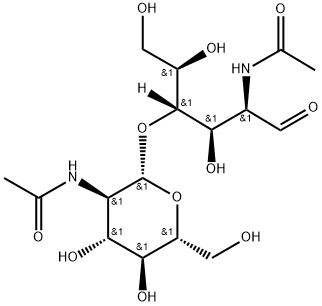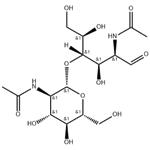Chemical Properties
White Solid
Uses
Diacetylchitobiose/Chitobiose, a dimer of β(1,4) linked N-acetyl-D glucosamine, is used as an alternative source of N-acetylglucosamine by some bacteria. It is used in fermentation research to study, differentiate and characterize chitobiose transporter systems and enzymes such as β-N-acetylglucosaminidase(s) and chitobiose phosphorylase(s).
Uses
lectin inhibitor, immunopotentiator
Uses
An inhibitor of lysozyme, reverses myocardial depression and lessens norepinephrine requirements in Escherichia coli sepsis in dogs.
Definition
ChEBI: N,N'-diacetylchitobiose is the N,N'-diacetylated derivative of chitobiose, but with no stereodesignation for the anomeric carbon atom. It has a role as a human metabolite, an Escherichia coli metabolite and a mouse metabolite. It is functionally related to a beta-D-glucosaminyl-(1->4)-D-glucosamine.
Biochem/physiol Actions
In chitinolytic bacteria, such as Vibrio, Streptomyces and Serratia, N,N′-Diacetylchitobiose (GlcNAc2) is not only a major breakdown product of chitinase, but it is also the smallest substance that induces chitinase production. It can also be utilized as a carbon source by E. coli, which does not express chitinases, but is exposed to GlcNAc2 produced by intestinal chitinolytic bacteria. In most organisms, the uptake of GlcNAc2 occurs via the phosphoenolpyruvate:glycose phosphotransferase system (PTS). GlcNAc2 has also been used as a substrate or inhibitor to study the activity of glycolytic enzymes.
Purification Methods
Recrystallise N,N'-Diacetylchitobiose from aqueous MeOH or aqueous EtOH/1,2-dimethoxyethane. [Zilliken et al. J Chem Soc 77 1296 1955, Beilstein 18/11 V 147.]




